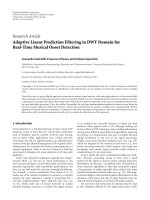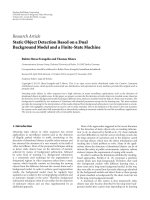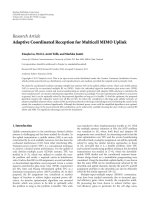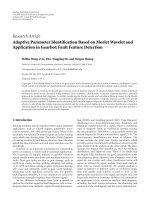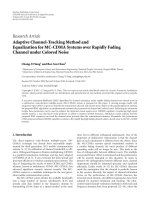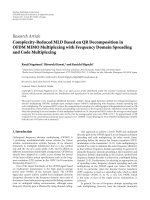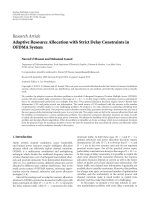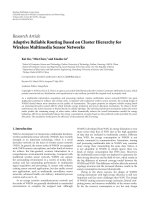Báo cáo hóa học: "Research Article Adaptive Reliable Routing Based on Cluster Hierarchy for Wireless Multimedia Sensor Network" docx
Bạn đang xem bản rút gọn của tài liệu. Xem và tải ngay bản đầy đủ của tài liệu tại đây (888.39 KB, 10 trang )
Hindawi Publishing Corporation
EURASIP Journal on Wireless Communications and Networking
Volume 2010, Article ID 567952, 10 pages
doi:10.1155/2010/567952
Research Article
Adaptive Reliable Routing Based on Cluster Hierarchy for
Wireless Multimedia Sensor Networks
Kai Lin,
1
Min Chen,
2
and Xiaohu Ge
3
1
School of Computer Science and Technology, Dalian University of Technology, Dalian, Liaoning 116024, China
2
School of Computer Science and Engineering, Seoul National University, Seoul 151-742, Republic of Korea
3
Department of Electronics and Information Engineering, Huazhong University of Scie nce and Technology,
Wuhan, Hubei 430074, China
Correspondence should be addressed to Kai Lin,
Received 31 March 2010; Accepted 7 May 2010
Academic Editor: Liang Zhou
Copyright © 2010 Kai Lin et al. This is an open access article distributed under the Creative Commons Attribution License, which
permits unrestricted use, distribution, and reproduction in any medium, provided the original work is properly cited.
As a multimedia information acquisition and processing method, wireless multimedia sensor network(WMSN) has great
application potential in military and civilian areas. Compared with traditional wireless sensor network, the routing design of
WMSN should obtain more attention on the quality of transmission. This paper proposes an adaptive reliable routing based
on clustering hierarchy named ARCH, which includes energy prediction and power allocation mechanism. To obtain a better
performance, the cluster structure is formed based on cellular topology. The introduced prediction mechanism makes the sensor
nodes predict the remaining energy of other nodes, which dramatically reduces the overall information needed for energy
balancing. ARCH can dynamically balance the energy consumption of nodes based on the predicted results provided by power
allocation. The simulation results prove the efficiency of the proposed ARCH routing.
1. Introduction
With he development of inexpensive multimedia hardware,
wireless multimedia sensor networks (WMSN) have recently
emerged as an important technology, which is a novel
derivative network on the basis of wireless sensor network
(WSN). In general, the sensor nodes of WMSN are equipped
with CMOS camera, microphone, and other kinds of sensors
for achieve the fine-grained, accurate information in a
comprehensive environmental monitoring. Compared with
traditional wireless sensor network, WMSN can capture
the surrounding environment in a variety of media infor-
mation and has outstanding performance in multimedia
signal acquisition and processing. It cannot only enhance
existing sensor network applications, but also enable several
new applications, such as multimedia surveillance sensor
networks, advanced health care delivery, industrial process
control, and so on [1–4].
As an energy sensitive noninfrastructure network and
the nodes of WMSN are generally distributed in unattended
environments to complete the assigned task. Although
WMSN is developed from WSN, its energy limitation is even
more severe than that of WSN due to the high quantities
of data that are included in multimedia content. Different
from WSN, the energy consumption in WMSN is not
mainly consumed in communication. Sometimes, sensing
and processing multimedia data in WMSN may consume
more energy than transmitting the same data. Hence, it
is not adoptable in WMSN to simply ignore these two
kinds of energy consumption like WSN does. Moreover,
the multimedia sensor nodes are deployed in sparseness for
their strong directives and far-field of view, which results in
the big difference of network coverage model between the
WMSN and WSN. This difference will also affect the network
topology structure and the increased distance results in the
energy consumption increased dramatically.
Owing to the above reasons, the design of WMSN
routing mechanism with high energy efficiency is still very
important and face more challenges than WSN. The design
of WMSN routing concerns energy constrains, limited com-
puting power, and memory availability of the sensor nodes.
By far, the resource consumption is not the only design
2 EURASIP Journal on Wireless Communications and Networking
target, a certain level of Quality of Service (QoS) is also
needed to guarantee delivering multimedia content, such as
communication reliability, real-time, and so on. Obviously,
it is a trade-off problem that the transmission of multimedia
data should meet the requirements of energy efficiency and
QoS assurance, which seriously increases the difficulty of
routing design. According to the status of sensor nodes in the
process of network operation, routing can be divided into
flat routing and clustering routing. Clustering routing first
appears in cable network, and it is also adaptable for WSN
on account of the good flexibility and high communication
efficiency. Similar to WSN, the WMSN routing is always built
on a hierarchical architecture, comprising several clusters in
almost same size where each cluster has several sensor nodes
and a cluster head. The obvious advantages of hierarchical
architecture in WMSN are as follows. First, for a real WMSN
contains hundreds or thousands of multimedia sensor nodes,
hierarchical architecture is efficient to divide and rule
for the application of distributed computation and QoS
management. Second, the sensory data are in high relativity
because the sensor nodes are unavoidable to be distributed
in redundancy. The unnecessary data transmission can be
reduced by data fusion process of cluster head node. Third,
most of sensor nodes can turn off radio model to reduce
energy consumption and communication conflicts in a quite
long period which can significant prolong the lifetime and
improve the QoS of the whole network. For these reasons,
the clustering routing is much suitable for WMSN than flat
routing, specially in large scale network.
The crucial guaranteed requirement of Qos is whether
the sending data from source data can be effectively received
by destination nodes. Since there are distortion, multipath
interference, and multitone jamming in wireless channel, the
package loss is unavoidable during transmission process. To
improve the network performance and meets the application
requirement, we make the reliable transmitting of end-to-
end as QoS requirement in our research. Although it is an
easy method to satisfy the reliability requirement by selecting
a much reliable route for data gathering, the energy of
some nodes will be used up quickly if only the quality of
communication is considered. Hence, the other important
problem we must concern is how to balance the energy con-
sumption of network. Aiming at the requirements of energy
equilibrium and reliability, we propose an adaptive reliable
routing based on cluster hierarchy(ARCH) for WMSN. The
ARCH routing can balance the energy consumption with
meeting the need of reliability between the source and
destination node. Moreover, we design a power allocation
mechanism to adjust the transmitting power of nodes and an
energy prediction mechanism to realize energy aware among
nodes. The main contributions of this paper are summarized
as follows.
(1) We design a self-adaptive power allocation mech-
anism, which can make sensor nodes meet the
reliability requirement by adjust their transmitting
power dynamically. It is very suitable for sensor node
to meet the low cost requirement of WMSN, too.
(2) We proposed prediction method of energy con-
sumption for WMSN, which can makes the sensor
nodes predict the remaining energy of other nodes.
The introduced prediction mechanism dramatically
reduces the overall information needed for balancing
energy consumption.
(3) We propose an adaptive reliable routing based on
cluster hierarchy(ARCH) for WMSN. By using power
allocation and energy prediction mechanism, the
ARCH routing can balance the energy consumption
with meeting the need of reliability between the
source and destination.
(4) We perform extensive simulation experiments to
evaluate ARCH by several performance indexes. The
results show that ARCH performs high efficiency in
wireless multimedia sensor network.
The rest of this paper is organized as follows. In Section 2,
some related works on the WMSN routing protocol are
presented. In Section 3, the system models and problem
statement are described. In Section 4,anadaptivepower
allocation mechanism is explained. We proposed an energy
prediction mechanism for WMSN in Section 5.InSection 6,
the ARCH routing is presented. The simulation results are
given in Section 7. Finally, Section 8 concludes our paper.
2. Related Works
In wireless multimedia sensor network, the routing design
need to guarantee delivering multimedia content with a
certain level of Quality of Service (QoS), such as commu-
nication reliability, real-time, and so on. Although provid-
ing QoS guarantees in WMSN during data gathering is
a very challenging problem, some approaches have been
proposed in the literature for QoS support. Especially, many
researchers have proposed some routing protocols with the
ability of energy apperceiving and QoS. These protocols can
meet the requirements of real-time and reliability in WMSN.
According to the different QoS, they are mainly divided into
two parts.
2.1. Reliability Routing Protocol. The typical protocols are
AFS [5]andReInforM[6]. In AFS, the rank of QoS is
introduced and the transmission reliability is guaranteed
by self-adaptive retransmitting mechanism. In ReInforM,
the transmission reliability and routing load are guaranteed
by multirouting and random retransmitting mechanism.
ReInforM considers the importance of the data in the packet
and can adapt to channel errors. ReInforM can send multiple
copies of a packet along multiple paths from the source
to the sink so that the data can be delivered with the
desired reliability. ReInforM uses the concept of dynamic
packet state in the context of sensor networks to control
the number of paths required for the desired reliability
based on local knowledge of the channel error rate and
topology. However, this protocol only addresses QoS in
terms of reliability, disregarding energy issues. In addition,
this protocol does not consider route delays when selecting
EURASIP Journal on Wireless Communications and Networking 3
multiple paths. In 2006, Felemban et al. propose MMSPEED
routing protocol [7]. MMSPEED considers the needs of
real-time and reliability, adopting the design conception of
MAC layer and network span. By localization algorithm and
multirouting mechanism, MMSPEED has good properties of
QoS and expendability. MMSPEED can well support flow
media and meet the needs of graphic and video to real-time
and reliability in WMSN. The drawback of MMSPEED is
complex algorithm, large energy consumption, which limits
its wide application in WMSN. The QoS routing approach
presented by utilizing the geographic location of sensor
nodesaswell.Thisprotocolassignsanurgencyfactorto
every packet depending on the remaining distance and the
time left to deliver the packet. It determines the distance
required for the packet to be sent closer to the destination
in order to meet its deadline. Each node assigns a priority
to all of its neighbors, according to their residual energy and
delay, as well as the priority of the packets, and packets are
forwarded to the highest priority nodes. Packets are sorted
in two different queues, one for nonrealtime traffic, and the
other one for real-time traffic. Real-time traffic is prioritized
based on its urgency factor, scheduling those packets with
more aggressive deadlines first for transmission. Reliability
is achieved by using duplication of information at the source
node. However, the protocol does not consider data aggrega-
tion and the network lacks a good decongestion scheme.
2.2. Real Time Routing Protocol. The typical ones are SAR
[8], RAP [9], and SPEED [10]. Here, SAR is a kind of
routing protocol with energy aware of QoS. Sensor nodes
can send the information met the needs of tree to the sink
node based on the path source, additional QoS measure,
and package priority rank. RAP uses a velocity monotonic
scheduler to prioritize packets and schedules them on the
basis of their required transmission speed. This protocol
does not consider energy issues and the number of hops
executed by the packets. SPEED is the first real-time routing
protocol for WMSN. It introduces a soft realtime end-to-
end to support all nonrealtime MAC protocols, providing the
management of controlling network traffic and multirouting
overload. A Weighted Fair Queuing (WFQ) approach is used
in every node to provide the required share of bandwidth
for both traffic classes. Path generation is performed in a
centralized manner, at the base station using an extended
version of Dijkstra’s Algorithm. The advantage of this
algorithm lies in the fact that it provides a guarantee for best-
effort transmission, while simultaneously trying to maximize
real-time traffic throughput. The main drawback is that
the algorithm requires complete knowledge of the network
topology at the base station to calculate multiple routes,
thereby limiting the scalability of this approach. An energy
aware QoS routing protocol for real-time traffic generated
by a wireless sensor network consisting of image sensors is
proposed by Akkaya and Younis in [11]. This approach finds
multiple network routes by using a minimum path cost. Such
kind of cost is a function of distance between nodes, node
residual energy, energy transmission, and error rates which
meet the requested end-to-end delay constraints. All trafficis
divided into best effort and real-time classes.
3. System Models and Problem Statement
3.1. Syste m Models
3.1.1. Network Model. In this paper, we adopts a WMSN
formed by n random deployed multimedia sensor nodes,
m gateway nodes, and one sink node. All the sensor nodes
are used for data collection in the monitoring area and do
not move after the deployment. The network architecture is
depicted in Figure 1. The sensor nodes are grouped into clus-
ters based on many criteria such as communication range,
number and type of sensors and geographical location. Each
cluster has a gateway node that manages the sensor nodes
in the cluster, which are significantly less energy-constrained
than sensor nodes. The gateway node will take charge of
sensor organization and network management based on the
QoS requirement and available energy in each sensor node.
All the sensor nodes are isomorphic with the same initial
energy and the same capacity of sensing, computation and
communication. The sink node is not limited by energy
and capacity. Each multimedia sensor node can adjust the
transmission power to save energy consumption and the
links are symmetrical. If the receiver knows the transmission
power, then the receiver can calculate the distance to the
transmitter by the intensity of the received signal.
3.1.2. Transmission Error Model. In our research, we assume
that path loss is close to log-normal shadow model [12],
which is
G
(
d
)
[
dB
]
= G
(
d
0
)
+ ηlog
10
d
d
0
+ X
σ
,
(1)
where G
d
is path loss, d represents the distance between
transmitter and receiver, d
0
is the reference range, η is the
coefficient of path loss. X
σ
is distributed in (0, σ
2
) following
Gaussian random process. The relationship between Packet
reception rate and SNR(signal to noise ratio) is as follows
prr
=
⎛
⎝
1 −Q
⎛
⎝
2γ
B
N
R
⎞
⎠
⎞
⎠
8ρF
,(2)
where Q(x)
=
∞
x
(1/
√
2π)exp(−x
2
/2)dx, γ represents SNR,
R is the noise bandwidth, ρ is data rate, F is code rate, and F
is data frame length.
3.2. Problem Statement. Now we begin to formulate the
problem. As shown in Figure 1, the network consists of
a series of multimedia sensor nodes, one sink node, and
some gateway nodes. These gateway nodes act as cluster
head nodes, which need to manage and collect the data sent
from the nodes in their clusters. Multimedia sensor nodes
complete monitoring task and send their data to gateway
nodes. In each cluster, the sensor nodes are the source
nodes and the gateway node is the destination node. Due to
communication capacity limitation, most of the senor nodes
need to send their data by multihop method to the gateway
node. There is at least one routing existed to collect data
between each sensor node and gateway node in one cluster.
4 EURASIP Journal on Wireless Communications and Networking
Sink node
Gateway (class head)
Multi-media sensor node
Figure 1: Network architecture.
12345
6
R
H
12
H
23
H
34
H
45
H
56
Figure 2: Reliable requirement for multihop path.
Although the transmission of multimedia data does not
require 100% reliability, it is still necessary to guarantee the
reliability of end-to-end. As the energy of sensor node and
bandwidth are both limited, it is difficult to transmit large
data of streaming media and needs more investigation to
design a novel routing to realize the reliable transmission
in network. We assume that there is one multihop path as
shown in Figure 2. The reliability between random neighbor
node i and j is H
ij
, the reliability of the requirement from
node 1 to 6 is R. Obviously, the data transmission should
meet the needs as follows:
H
ij
≥ r
ij
,
H
ij
≥ R,
1
≤ i ≤ 5, i +1= j. (3)
As the above description, it has to consider the energy
equilibrium of nodes besides of the reliability for the sake of
avoiding the energy hole resulted from some nodes running
out of their energy too fast. Based on the above two points,
our optimization object is to design a routing protocol that
can guarantee the reliability of data transmission and balance
the energy consumption while delivering data from all source
nodes in S to the sink node. This problem can be formulated
as follows
min
u∈S
Eu − E
2
s.t. for ∀u ∈ S, p
ru
= Q,
(4)
where E
u
represents the remaining energy of node u and
E represents the average remaining energy of all nodes. p
ru
represents the probability of data from node u that can be
correctly received. Q represents the reliable requirement of
data transmission. The constraint specifies that it should
guarantee the ensuring end-to-end reliability from each
source node to sink node.
4. Self-Adaptive Power Allocation Mechanism
Most transceiver chip supports programmable transmit
power. The transmit power level can be adjusted by configure
the corresponding status register. Take Cyclops based on
mica2 platform for an example, the power range of commu-
nication module CC2420 is in [
−25 dBm, 0 dBm], including
eight levels. The energy consumption of transmitting data is
E
tx
P
tx
=
8 f
R
P
cir
+
P
tx
ηP
tx
,(5)
where P
cir
is the circle power and η is the conversion
efficiency of power amplifier. The energy consumption of
receiving data is
E
rx
=
8 f
R
P
rx
,
(6)
where, P
rx
represents the receive power.
EURASIP Journal on Wireless Communications and Networking 5
0
0.05
0.1
0.15
0.2
0.25
Energy consumption (mJ)
00.20.40.60.81
Tr an sm it p ow er (m W)
Transmit data
Receive data
Figure 3: Energy consumption with different transmit power.
To have an intuitive expression on energy consumption
of data transmission, let f
= 128bytes, P
cir
= 26.5mW,
η(P
tx
) = 0.06e
0.095P
tx
(dBm)
, P
rx
= 28 mW, R = 256 kbps. The
relationship between transmit power and energy consump-
tion is shown in Figure 3.
As mentioned above, there must be at least one route
between each source node and the sink node to complete the
data gathering. We use R(u, p, h) for representing the route p
from node u to the sink node with h hops. For the purpose of
energy conservation and reducing communication conflict,
we also assume that the same data packet using only one
route to send. Considering the average rate of data reception
by single hop transmission, we use G
i
and L
i
for representing
the power gain and transmit power level on the hop i of route
p, respectively. The reliable transmission rate is p
i
(G
i
, L
i
),
which is related to G
i
and L
i
. G
i
is a Gaussian distributed
random variable. When G
i
is independent and identically
distributed, it is necessary for the reliable transmission rate
to meet the transfer request from node u to the sink node by
the route p is
P
u, p, h
=
h
i=1
p
i
(
G
i
, L
i
)
≥ R,
(7)
where R is the lowest reliable requirement.
SNR increases with the increasing of transmission power,
which results in the improvement of transmission reliability.
In (7), P(u, p, h) is determined by each p
i
(G
i
, L
i
)ofroutep.
When we use a higher L
i
,ahigherp
i
(G
i
, L
i
) will be obtained.
The increments of reliable transmission rate by increasing
one level transmit power is defined in:
ΔRi
=
P
rr
(
G
i
,
(
L
i
+1
))
P
(
G
i
, L
i
)
, L
i
∈
[
1, 2, 3, , L
]
. (8)
It can be known from Figure 3 that the increasing of
transmit power level will result in more energy consumption.
In order to save more energy of the network, we use the
critical condition of (7) and introduce the power control
algorithm presented by Kwon H [13]. The reliability is
guaranteed by gradually increasing the transmit power level.
If all the nodes adopt the maximum transmit power level and
still cannot meet the reliable transmission requirement, it has
to rebuild another route.
According to (5), our optimization target is to guar-
antee the reliability of end-to-end and balance the energy
consumption of nodes in the network. To achieve the
optimization target, we can allocate higher transmit power
level to the multimedia sensor nodes with more remaining
energy. Obviously, we must solve the problem that how to
realize energy aware between nodes in priority.
5. Energy Prediction Mechanism
In order to achieve the energy equilibrium, we first need
to know the remaining energy of each multimedia sensor
node. However, the energy aware among nodes is difficult
to be achieved in WMSN, which is due to the high com-
munication cost for constituent updating their remaining
energy information. At the same time, some problems are
also brought, such as network congestion and transmission
delay. To solve this problem, we propose an energy prediction
mechanism for WMSN, which can make sensor node know
the remaining energy of other nodes without constituent
updating.
During the operation process of WMSN, the energy
consumption of multimedia sensor nodes is not stable but
depends on the their working states. Energy consumption of
sensor node depends on the different working states. Nodes
can turn to sleep when they have no any task. The working
state conversion is necessary to save energy for WSMN,
but it also increase the difficulty for predicting energy con-
sumption. In traditional sensor node, the energy is mainly
consumed on receiving and transmitting process, where the
energy consumption on data sensing and processing can
be neglected. However, the total energy consumptions of
multimedia sensor nodes in WMSN increase greatly as the
nodes need to collect the data from audio, video, and graphic.
It consumes much more energy of sensing and processing
than those of communication.
According to the operation of multimedia sensor nodes
under the clustering hierarchy in WMSN, we design a
state conversion model for intracluster nodes as shown in
Figure 4. There are seven working states in this model.
(1) In sleep state, the sensor and communication module
are close, the sensor nodes have no any task.
(2) In sense state, the sensor module is close and the
communication module is open, the sensor nodes
collect the multimedia.
(3) In idle state, the sensor module is close and the
communication module is open, the sensor nodes
monitor communication channel.
(4) In receive state, the sensor module is close and the
communication module is open, the sensor nodes
receive data from other nodes.
6 EURASIP Journal on Wireless Communications and Networking
Transmit Sense
Process Sleep Idle
ReceiveAccess
Figure 4: Model of working state conversion.
(5) In transmit state, the sensor module is close and the
communication module is open, the sensor nodes
transmit data to other nodes.
(6) In process state, the sensor and communication mod-
ule are close, the sensor nodes process multimedia
data.
(7) In access state, the sensor and communication are
close, the sensor nodes complete reading and writing
memory.
All the working state conversion occurs only at the end of
one time-step. It is worthy mentioning that in transmit state,
the energy consumption of node is different for transmitting
data by various power level.
Based on this state conversion model, we can realize
the energy aware among nodes. Similar to [14], we use
Markov chain to simulate the working states of multimedia
sensor nodes. Each node has a series of random variants
X
0
, X
1
, X
2
, , which describes different working states. P
ij
is
further defined as one-step diversion probability, which can
be expressed by
P
ij
= P
X
m+1
= j | X
m
= i
.
(9)
The N-step diversion probability is defined in:
Pij
(
n
)
=
M
k=1
P
ik
(
r
)
P
kj
(
n
− r
)
,for0<r<n.
(10)
If the node is currently in state i, the number of time-
slot that it will stay in state s in the next T time-step can
be expressed as
T
t
=1
P
is
(t). We use E
s
for representing the
energy consumption of node staying at state s in one time-
step. Then, the total energy consumption in the next T time-
step can be calculated by
E
T
=
M
s=1
⎛
⎝
T
t=1
P
is
(
t
)
⎞
⎠
×
E
s
. (11)
On the basis of working states statistic, the nodes can
calculate the energy consumption of itself or other nodes in
the next T time-step by (11)[14]. The accuracy of energy
prediction is influenced by the validity of the probability
diversion matrix.
6. ARCH Routing
In this section, we propose an adaptive reliable routing
based on cluster hierarchy(ARCH) for WMSN. The above
mentioned self-adaptive power allocation and energy pre-
diction mechanism are both used in ARCH. To obtain a
better performance, the cluster structure is formed based
on cellular topology. The design objective of ARCH is to
guarantee energy balance and meet the needs of reliability
between the source and destination.
6.1. Establishment of Routing. With the existence of gateway
node, we can easily establish the cluster structure for
purpose. Here, the cluster structure is generated by cellular
topology. In this structure, the monitoring area is divided
into cellular virtual unit cells with same size. At the center of
each unit cell, a gateway node plays as cluster head node and
the rest ordinary nodes as member nodes belong to the unit
cell.
In the initialization phase, each gateway node sends one
ADV message including the ID of this node and the multi-
media sensor nodes receive these ADV messages. In general,
each sensor node can receive more than one ADV message.
At this time, the sensor node needs to compare the signal
strength of the received messages and select the gateway node
with strong signal to join in its cluster. If the gateway node is
located at the right position, we can establish an ideal cluster
structure based on cellular topology by this way.
Considering low cost in network, the amount of gateway
node should be as few as possible. We adopt a intracluster
multihop communication method. To guarantee all the
sensory data can be successively transmitted to the sink node,
at least one route is necessary to be established for each
source node to reach its cluster head node. According to
the communication ability of sensor nodes, each cluster is
divided into many concentric coronas with the center of
gateway, denoted as C
1
, C
2
, , C
N
. For avoiding the loss
of efficiency data, we set the width of coronas equaling to
the communication distance by using lowest transmit power
level. From corona C
1
, the nodes in corona C
i−1
send ADV
messages with the node ID to corona C
i
. By these ADV
message, each node in corona C
i
(2iN) can find a relay node
from the corona C
i−1
. All the nodes in the corona C
1
can
communicate with the gateway node directly. Figure 5 shows
the intracluster multihop routing.
When each node finds its relay node, the establishment
of routing in cluster is finished. Gateway node is responsible
for gathering and processing all the sensory data, then send
these data to the sink node. If the network scale is small, each
gateway node can communicate with the sink node directly.
If the network scale is large, even though gateway nodes have
stronger ability than those of ordinary sensor nodes, they
EURASIP Journal on Wireless Communications and Networking 7
Figure 5: Intra-cluster multihop routing.
still need using multihop method to transmit their data to
the sink node. We can form robust inter-cluster multihop
routings according to the property of cellular structure. As
shown in Figure 6, there are six gateway nodes with the
same distance to the center node O (sink node). They can
send data to the sink node directly. The external data can
be transmitted by more than one pathway to guarantee the
success delivery to the sink node. For example, the gateway
node A can send data to O by different pathways: A
→
C → F → O, A → D → G → O, A → B →
D → G → O,orA → C → D → G → O.Whena
pathway is broken, it is convenient to find another pathway
as alternative. Additionally, some important data can be
sent by more than one pathway to guarantee its successful
transmission to the destination node.
6.2. Time-Slot Assignment. To avoid the conflicts during data
transmission, the gateway nodes need to set up a table of time
division multiple access (TDMA) to distribute the time-slot
for sensor nodes belonging to its cluster. According to the
TDMA table, the member sensor nodes can turn off their
radio module in the nontransmission period to reduce their
energy consumption.
When the intracluster single-hop communication
method is adopted, the TDMA table is a simple one variable
linear table and each member sensor node can be distributed
an isometric time-slot. But for ARCH with intracluster
multihop communication method, this kind of distribution
is not suitable any longer. Here, the cluster head node will
not distribute time-slot for all the member sensor nodes,
but only for the member sensor node with one hop. If a
member node does not contain any son node, its time-slot
is distributed as 1, then notify to the upper sensor node. If
the member node contains only one son sensor node, they
O
H
G
F
E
D
C
BA
Sink
+
Figure 6: Inter-cluster multihop routing.
G
3
5
5
4
4
1
1
1
1
3
1
1
1
1
2
2
1
1
2
1
1
Gateway
Sensor node
A
B
C
D
E
Figure 7: Intra-cluster time-slot distribution of multihop.
will set the time-slot distribution as same as the son sensor
node. If the member sensor node contains more than one
son node, the time-slot of this member node is distributed
as sum of all its son nodes. Figure 7 shows an example of
intracluster the time-slot distribution.
For node A, B,andD do not have any son nodes, they are
assigned one time-slot for transmitting their data. Node C
serves as a relay node for node A and B, so it is assigned two
time-slots. Node E serves as a relay node of node C and D,so
it is assigned three time-slots. In this example, the gateways
node informs each node in its cluster of the time-slots it is
going to receive packets from other nodes and the time-slots
it can use to transmit the packets.
8 EURASIP Journal on Wireless Communications and Networking
6.3. Realization of Optimization Target. In order to reduce
energy consumption, transmit power level L
i
should be set
as 1 for all multimedia sensor nodes. Then, the intracluster
routing starts to be established. As mentioned above, all the
nodes in corona C
i
select their relay nodes in corona C
i−1
.
If the routing is failed to be established, the L
i
of nodes in
this transmitting direction will be set as 2. If it is still not
successful until L
i
of these nodes equal to L, the process of
routing establishment will stop.
For an established route, it needs to determine whether
it is satisfy for (7). If the route does not meet the condition,
the power allocation algorithm will be started. In network
initialization phase, all sensor nodes have the same remaining
energy. We can randomly select routing nodes and increase
their transmit power level until met the requirement.
To achieve energy aware, According to (12), each node
calculate its own energy consumption rate as ΔE
= E
T
/T,
then notify it to other nodes on the route. Each node
can predict the remaining energy of other nodes by ΔE,
avoiding a large amount information exchange. To eliminate
the unavoidable predicting error, each node should keep its
recent ΔE and recalculate it when error occurs, then notify it
with its current remaining energy to the other nodes on the
route. To reduce updating number, we set an error threshold
F. Only when the predicting error is higher than the value
threshold, sensor nodes need to resend the message.
In order to balance the network energy consumption, we
dynamically adjust the transmit power level of sensor nodes
based on their remaining energy. We use S
p
for representing
the node set on route p.Foranynodei belonging to S
p
,ifit
met the following (12), the transmit power level of all nodes
in S
p
will be reallocated.
i∈S
p
E
i
E
i
− 1
2
>D
, (12)
where D is a configurable threshold. Obviously, increasing
energy consumption of the node with more remaining
energy can meet our optimization goal. Under the premise
of meeting (7), the nodes with higher remaining energy will
be allocated higher transmit power level, while the nodes
with low remaining energy just need to adopt transmit power
level which can satisfy the requirement of single-hop reliable
transmission.
7. Simulation and Analysis
In this section, we evaluate the performance of the ARCH
via simulation experiments. We assume that 400 multimedia
sensor nodes and 8 gateway nodes are uniformly deployed
into a circle with diameter of 200 m, where a sink node is
at the center of circle. The initial energy of each senor node
has 50 J. All the sensor nodes are the source of information
and can be the relay nodes. The original packet is 128
bytes generated by each sensor node. Referred to the index
value of CC2420 chip, configure eight transmit power level:
−25 dBm, −15 dBm, −10 dBm, −7dBm, −5dBm, −3dBm,
−1dBm,and0dBm.
45
46
47
48
49
50
Energy (J)
0 250 500 750 1000
Time(s)
Predicted value
Actual value
Figure 8: Predicted value and actual value.
0.4
0.5
0.6
0.7
0.8
0.9
1
Remaining energy ratio
12345678
Number of transmit power level
ARCH
ARCH without EP
ARCH without PA
Figure 9: Remaining energy ratio with different number of
transmit power level.
Figure 8 records the node’s remaining energy and the
value of predicted result in 1000 s by ARCH. It can be seen
that the value of predicted result is very close to the actual
value. There are only three times that the error exceed when
the threshold is set at 3%. When the error exceeds the
threshold, the nodes will recalculate the parameter of energy
prediction and make the current actual value as the initial
value for the next prediction.
Figure 9 shows the normalized remaining energy with
different number of transmit power level during 1000 s. It
can be seen that the normalized remaining energy by ARCH
increased obviously with increasing the number of transmit
power level. If the energy prediction or power allocation
mechanism are not adopted (ARCH without EP or PA), the
EURASIP Journal on Wireless Communications and Networking 9
0.4
0.5
0.6
0.7
0.8
0.9
1
Average remaining energy ratio
0.85 0.86 0.87 0.88 0.89 0.9
Reliability requirement
ARCH
ARCH without EP
ARCH without PA
Figure 10: Remaining energy ratio with reliability requirement.
0.4
0.5
0.6
0.7
0.8
0.9
1
Remaining energy ratio
2345678
Number of gateway node
ARCH
ARCH without EP
ARCH without PA
Figure 11: Remaining energy with different number of gateway
node.
remaining energy of nodes decreased obviously. Specially,
the energy consumption of network is slightly influenced by
number of transmit power level for ARCH without PA.
Figure 10 shows that the increasing reliability require-
ment will lead to declining remaining energy. Although a
higher transmit power level will increase energy consump-
tion, the reliability of end-to-end will be effectively enhanced
by the power allocation. The increased energy consumption
for a high reliability is far less than that of retransmission
energy with a low reliability. Therefore, the remaining energy
of ARCH is much more than that of ARCH without PA.
Figure 11 shows that the normalized remaining energy
with different number of gateway nodes during 1000 s. It
can be seen that the remaining energy of network increase
with increasing the number of gateway nodes. The increased
number of gateway nodes decreases the area of cluster, hence
the intracluster transmission hop is also reduced, which is
benefit for saving energy.
8. Conclusion
As a resource-constrained network, wireless multimedia
sensor network should try to reduce the unnecessary energy
consumption. In this paper, we study the optimization of
balancing energy consumption with reliable data trans-
mission. Aiming at the needs of energy equilibrium and
reliability, we propose an adaptive reliable routing based on
cluster hierarchy(ARCH) for WMSN. The ARCH routing
can balance the energy consumption with meeting the
need of reliability between the source and destination. To
achieve better performance, we form the cluster structure
by cellular topology. Moreover, we design a power allocation
mechanism to adjust the transmitting power of nodes and
an energy prediction mechanism to realize energy aware
among nodes.We perform extensive simulation experiments
to evaluate ARCH by several performance indexes. The
results show that ARCH performs high efficiency on energy
equilibrium and reliability in wireless multimedia sensor
network.
Acknowledgments
The authors acknowledge the support from the National Nat-
ural Science Foundation of China (NSFC), Contract/Grant
no. 60872007; National 863 High Technology Program of
China, Contract/Grant no. 2009AA01Z239; The Ministry
of Science and Technology (MOST), International Science
and Technology Collaboration Program, Contract/Grant no.
0903.
References
[1] I. F. Akyildiz, T. Melodia, and K. R. Chowdhury, “A survey
on wireless multimedia sensor networks,” Computer Networks,
vol. 51, no. 4, pp. 921–960, 2007.
[2] E. G
¨
urses and
¨
O. B. Akan, “Multimedia communication in
wireless sensor networks,” Annals of Telecommunications, vol.
60, no. 7-8, pp. 899–827, 2005.
[3] S. Misra, M. Reisslein, and G. Xue, “A survey on multimedia
streaming inwireless sensor networks,” IEEE Communications
Surveys and Tutorials, vol. 10, no. 4, pp. 18–39, 2008.
[4] K. Lin, L. Wang, K. Li, and L. Shu, “Multi-attribute data fusion
for energy equilibrium routing in wireless sensor networks,”
KSII Transactions on Internet and Information Systems, vol. 4,
no. 1, pp. 5–24, 2010.
[5] S. Bhatnagar, B. Deb, and B. Nath, “Service differentiation
in sensor networks,” in Proceedings of the 4th International
Symposium on Wireless Personal Multimedia Communications,
pp. 892–898, Aalborg, Denmark, 2001.
[6] B. Deb, S. Bhatnagar, and B. Nath, “ReinforM: reliable infor-
mation forwardingusing multiple paths in sensor networks,”
in Proceedings of the 28th Annual IEEE International Conference
on Local Computer Networks, pp. 406–415, Los Alamitos, Calif,
USA, 2003.
10 EURASIP Journal on Wireless Communications and Networking
[7] E. Felemban, C G. Lee, and E. Ekici, “MMSPEED: multipath
multi-SPEED protocol for QoS guarantee of reliability and
timeliness in wireless sensor networks,” IEEE Transactions on
Mobile Computing, vol. 5, no. 6, pp. 738–754, 2006.
[8] K. Sohrabi, J. Gao, V. Ailawadhi, and G. J. Pottie, “Protocols for
self-organization of a wireless sensor network,” IEEE Personal
Communications, vol. 7, no. 5, pp. 16–27, 2000.
[9]L.Chenyang,B.M.Blum,T.F.Abdelzaher,J.A.Stankovic,
and H. Tian, “RAP: a real-time communication architecture
for large-scale wireless sensor networks,” in Proceedings of the
8th IEEE Real-Time and Embedded Technologyand Applications
Symposium, pp. 55–66, San Jose, Calif, USA, 2002.
[10] T. He, J. A. Stankovic, C. Lu, and T. Abdelzaher, “SPEED:
a stateless protocol for real-time communication in sensor
networks,” in Proceedings of the 23rd IEEE International
Conference on Distr ibuted Computing Systems (ICDCS ’03),pp.
46–55, Providence, RI, USA, 2003.
[11] K. Akkaya and M. F. Younis, “Energy and QoS aware routing in
wireless sensor networks,” Cluster Computing, vol. 8, no. 2-3,
pp. 179–188, 2005.
[12] T. S. Rappaport, Wireless Communications: Principles and
Practice, Prentice-Hall, Upper Saddle River, NJ, USA, 2nd
edition, 2002.
[13]H.Kwon,T.H.Kim,S.Choi,andB.G.Lee,“Cross-
layer lifetime maximization under reliability and stability
constraints in wireless sensor networks,” in Proceedings of the
IEEE International Conference on Communications (ICC ’05),
vol. 5, pp. 3285–3289, May 2005.
[14] R. A. F. Mini, A. A. F. Loureiro, and B. Nath, “Prediction-based
energy map for wireless sensor networks,” in Proceedings of the
Personal Wireless Communications, vol. 2775 of Lecture Notes
in Computer Science, pp. 12–26, 2003.
